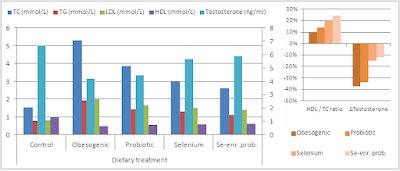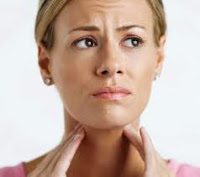 |
| Image 1: With enough selenium in vivo, "in vitro" (-fertilization) may not be necessary. |
If you have not heard about it in one of my
previous blogposts, you may probably heard about the
antioxidant, pro-fertility effects of selenium in the context of Tim Ferris' "selenium experiment" in the
4-Hour-Body. Ferris claimed that by just eating a handful of Brazil nuts (544µg selenium per ounce) every day shot his testosterone levels and libido through the roof. Now, what most people probably overheard, though, was that
Ferris was selenium deficient to begin with. Just as every bodybuilder's holy grail, zinc, selenium won't help up your testosterone or fertility if you have already plenty of the potentially toxic trace mineral in your diet. In view of its
central role in the antioxidant defense system of our bodies, it is however likely that selenium requirements increase, whenever our bodies are exposed to increasing amounts of oxidative stress.
When your body fat sets your testicles on fire, selenium may come to a rescue...One of the most common causes of increased oxidative stress, these days, are the increased levels in highly oxidizable very-low density cholesterol and triglyceride levels which appear to be an almost inevitable consequence of the "modern" lifestyle (=sitting on the couch and washing down your fast-food, as well as your low-fat "healthy" cereals, pasta and rice with soda). A recent study from scientists from the
Institute of Nutritional and Metabolic Disorders of Domestic in China does now show that an adequate amount of dietary or supplemental selenium, which is, as you may gather from the data in table 1, pretty scarce in everything that was not grown or raised on selenium-rich soil, may not be able to reverse all negative side-effects, but could ameliorate them so that reproduction would still be possible (
Ibrahim. 2011).
 |
| Table 1: Selenium content of common foods (based on data from the NIS. 2011) |
While the basal diet, which had been enriched with cholesterol, lard and cholic acid, so that it would mimic the obesogenic high carb + high fat diet, researchers love to
mislabel HFD (high fat diet), contained only
0.04 µg/g of selenium (without the addition the lard, i.e. for the control group, the se-content was 0.05µg/g), both the inorganic selenium HF-diet and the diet of the animals that received a combination of (organic) selenium (75% selenium-methionine) and probiotics (C. utilis and S. thermophilus strains) contained ~6x the amount of selenium (0.3µg/g chow). For humans this would translate to
~1.2µg/kg and 7µg/kg, respectively (since the scientists did not report food intake and body weight of the animals, I based this calculation on the respective data from other HFD feeding studies with mice).
Amelioration? Yes! Reversal / complete prevention? No!After 75 days on control, high fat, high fat + probiotic only, high fat + inorganic selenium only, and high fat + 90% organic selenium + probiotic diets, the testis of the mice showed histopathological changes even a non-expert as I am one would identify as "probably not healthy" (cf. illustration 1):
 |
| Illustration 1: Compilation of the histopathological examination of murine testes (H & E, ×400; based on Ibrahim. 2011) |
The evident
degenerations, decreases in cell population, and irregularities went hand in hand with a pretty profound changes in the quality of sperm (cf. figure 1), which were ameliorated, yet
not prevented in the selenium and selenium + probiotic groups.
 |
| Figure 1: Measures of sperm quality - sperm count and motility (left); relative incidence of sperm with abnormal heads and tails (right; data based on Ibrahim. 2011) |
In that, it is noteworthy that the selenium + probiotic (SePro) group had an only 1.5x increased amount of sperm with abnormal tails. The latter can thusly hardly be the reason for the -20% reduction in overall sperm motility.
 |
| Figure 2: Lipid (left axes) and testosterone (right axes) levels in the different groups (left); HDL to total cholesterol ratio and change in testosterone levels compared to control (right; data calculated based on Ibrahim. 2011) |
In view of the fact that the male gonads do not only produce sperm, but also testosterone, it is not surprising that selenium and selenium + probiotic supplementation had a similar ameliorative effect on the diet induced reduction -47% reduction in testosterone (cf. figure 2). The +3% increase in serum testosterone (over the obesogenic diet group) in the probiotic only group, on the other hand, lacked statistical significance.
 |
| Image 2: The importance of selenium for thyroid function, specifically the local conversion of the "inactive" T4 to the "active" T3 is not the only reason why women should try to achieve adequate selenium intakes, as well. |
Selenium for women? While it appears that research has hitherto focused on the role selenium plays in male health, there is a handful of studies which suggest that
adequate levels are just as important for women, as they are for men. The results of a Polish study from 2006, for example, stand in line with the, as of late, controversial anti-carcinogenic effect selenium is supposed to have on prostate cancer. According to the authors, the provision of selenium supplements to women with a genetic disposition for breast and ovarian cancer led to a
small, but statistical significant reduction in cancer rates (
Huzarski. 2006). In 2009, Hermsdorff et al. observed a statistical significant inverse correlation between selenium intake and serum levels of
retinol-binding-protein 4, a marker of whole body inflammation and purported contributer to insulin resistance and diabetes (
Yang. 2005), in 74 young (~20y) healthy women (
Hermsdorff. 2009). In post-menopausal women, Llaneza et al. found a
non-negligible association of low-serum selenium levels and higher LDLc and triglyceride levels (
Llaneza. 2009). A 2007 study by Negro et al. underlines the particular importance of adequate selenium levels for thyroid health during and immediately after pregnancy (
Negro. 2007). And according to a recent review of the role of selenium in reproductive health,
low selenium levels in the follicular fluid are a characteristic feature of "unexplained infertility" in women.
As far as the "potency" of the probiotics is concerned, the study was thusly quite disappointing. That the scientists who were proud to have developed a "Se-enriched probiotic as a new feed additive product for promoting animal industries" do not explicitly state that, is understandable, but won't stop me to repeat my previous recommendation to just add a handful of brazil nuts to your diet on a regular basis to make sure you satisfy your selenium requirements.
Selenium intoxication from Brazil nuts? I don't think so... |
| Image 3: Eating lots of brazil nuts and other selenium rich foods until they achieve what the US consider "toxic" serum and plasma levels does not seem to impair the health of the inhabitants of the regions around the Tapajós River in Brazil - on the contrary, their cardiovascular health is outstanding (Lemire. 2011) |
That this practice is not going to result in selenium toxicity has, by the way, been shown only very recently in one of those studies that analyze traditional diets, which have become so in-vogue, as of late. Lemire et al., who analyzed blood (B-Se) and plasma (P-Se) samples from members of the communities which live along the Tapajós River in Brazil, did not only find that these people had selenium levels well beyond what is "considered toxic" in the US, they also state that their results "support the
need to re-assess Se toxicity considering factors such as the chemical form of Se exposure, route of exposure (inhaled versus ingested), co-exposures to toxic elements such as mercury" and hint at "a possible association between high Se status and cardiometabolic health in this study population." (
Lemire. 2011) So, men or woman, fertile or infertile, fat or lean... you better make sure you get your share of brazil nuts, today ;-)






